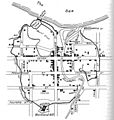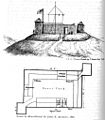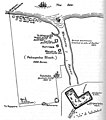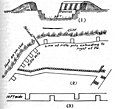The Taranaki Wars (1860-66)
| The New Zealand Wars | ||
|---|---|---|
| Taranaki (1860-61) | Waireka | Puketakauere | Mahoetahi | Matarikoriko | Huirangi | Pukerangiora | Wairau | Katikara | Allen's Hill | Kaitara | |
Contents
- 1 Introduction
- 1.1 Waireka (28th March 1860)
- 1.2 Puketakauere (27th June 1860)
- 1.3 Mahoetahi (6th November 1860)
- 1.4 Matarikoriko (30th December 1860)
- 1.5 Huirangi (23rd January 1861)
- 1.6 Pukerangiora (December 1860-January 1861)
- 1.7 Wairau (4th May 1863)
- 1.8 Katikara (4th June 1863)
- 1.9 Allen's Hill (2nd October 1863)
- 1.10 Kaitara (25th March 1864)
Introduction
The Waitara dispute
Waireka (28th March 1860)
28 March 1860. The first major engagement in Taranaki Wars occurred around Kaipopo pa, Waireka. Attempting to get reluctant settlers in from outlying areas, soldiers were attacked by Maori from nearby Kaipopo pa. It was quite a scattered engagement, with a number of different Maori and European groups firing at each other in the streams and bush leading down to the sea.
Puketakauere (27th June 1860)
After the battle of Waireka, both Maori and Pakeha raided each other's settlements, destroying crops and buildings. The Europeans established Camp Waitara for protection. When Maori began to fortify the twin pa Puketakauere and Onukukaitara, Major Nelson decided to attack. Onukukaitara was visible from the soldiers' camp, but it represented a false target. It was a simple stocade that contained only a few warriors[1] Artillery was concentrated on Onukukaitara while Puketakauere was relatively unscathed. When the second pa was discovered, the European attack was split in two and easily repelled by Hapurona's warriors. The result was a rout: over 30 British soldiers were killed compared to 6 or 8 Maori. It was a crushing defeat for the overly-confident Europeans.
Mahoetahi (6th November 1860)
Following news of the victory at Puketakauere, many warriors from Ngati Maniapoto, Ngati Haua and other Waikato iwi converged on Taranaki to support Wiremu Kingi. When news of their movement into the area reached Major-General Pratt, he was determined to act decisively before Maori threatened New Plymouth. British troops marched out towards Mahoetahi and were soon engaged in skirmishes as they closed in on the pa. Fighting intensified as the British charged the pa, with the Waikato warriors eventually retreating with the loss of around 20 men. New Plymouth resounded with stories of the British bravery and their rout of the enemy.
Matarikoriko (30th December 1860)
Following the deaths of a number of settlers around New Plymouth, Major-General Pratt decided to attack several nearby pa. He gathered together artillery he could use to beseige the pa, and marched nearly 1000 men towards Kairau on 29th December 1860. A redoubt was established 1,100 yards from Matarikoriko under sporadic gunfire from riflepits nearby. On the 30th December, the British opened fire on the pa, expending 120 artillery rounds and 70,000 rounds of rifle ammunition in 24 hours. On the morning of the 31st it was discovered that the pa was abandoned.
Huirangi (23rd January 1861)
The redoubt established at Kairau was the first of 8 that eventually stretched towards Te Arei. The second and third of these positions were established by the 23rd January 1861 when Maori launched their next attack on the British. An hour before daybreak musket fire began around all three redoubts before concentrating their attention on redoubt No. 3. 140 warriors crept into the trenches around this newly-established position and began attempting to scale the earthworks and parapet, without success. Reinforcements from the first redoubt eventually arrived and force the remaining warriors to retreat. Maori losses were between 40-50 men.
Pukerangiora (December 1860-January 1861)
This battle is perhaps best known for the strategy Europeans adopted to try to win it: sapping. After trooping through the bush and attempting to storm this ancient pa, the British eventually turned to a tactic not often seen in New Zealand warfare. Sapping involves digging a trench towards the enemy pa, building redoubts along the way to consolidate gains and protect the trench. Major-General Pratt's sap was dug between 29 December 1860 and 18 March 1861, when the ceasefire was announced. This signaled the end of hostilities in Taranaki for a few years, although neither side was happy with anything less than a decisive victory.
- Pukerangiora/Te Arei
Wairau (4th May 1863)
After an hiatus of almost 18 months, hostilities erupted again in Taranaki is spectacular form. A group of 30-40 warriors attempted to ambush Governor Grey who was in the habit of traveling to Tataraimaka. As it turns out it was not Grey's party who was attacked, but a small military party. The ambush was sprung and nine out of the ten British soldiers were killed.
Katikara (4th June 1863)
On the 4th of June 1863, Colonel Warre crossed the Katikara river and attacked an incomplete pa near Tataraimaka, near St George's redoubt. The British surprised the defenders and killed about 40 warriors.
Allen's Hill (2nd October 1863)
2 British soldier and an unknown number of Maori warriors were killed on 2nd October at Allen's Hill five and a half miles from New Plymouth.
Kaitara (25th March 1864)
The pa established at Kaitara was a particularly strong defensive position. It was on a steep, high ridge with several parapets designed to cover both approaches to the pa. On the 25th March 1864, Colonel Warre with a force of 420 men made a slow assault on the pa, taking nine hours to move 2 and a half miles through the bush. After stubborn resistance from the defenders, the British eventually took the pa.
References:
- ↑ P.98, Belich.












